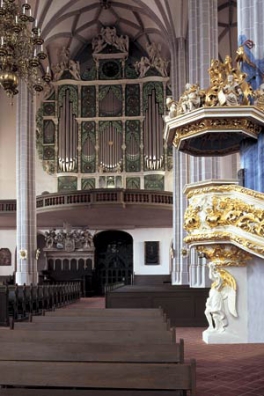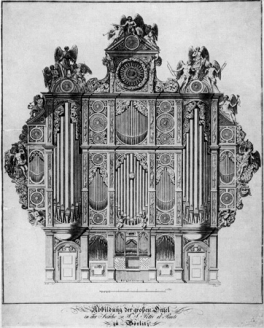


Görlitz, St. Peter und Paul („Sonnenorgel“)


Johann Eugen and Adam Orazio Casparini 1697-1703
State of preservation: After several severe repairs and modernisations during the 19th and 20th centuries the original instrument is lost; in 1997-2006 a historistic reconstruction with 4 manuals in close approach to Casparini was built.
The „Sun organ“ by Father and Son Casparini was one of the most famous organs of its time exemplifying some important tendencies and events for future organ developments. It represented a link of styles and ideas from the extreme south to the extreme north of the Habsburg empire. This also resembled the lifes of its builders, especially the life of Johann Eugen (aka Giovanni Eugenio) Casparini born near Görlitz but active in today's northern Italy. Well experienced with the different organ traditions within the Habsburg empire he created a sort of "Habsburg organ" hardly possible elsewhere, which deeply influenced organ making in Austria as well as Silesia (after the Prussian conquest) and Saxony.
Specification (contract 1697):
III+P; manuals C-c3)
HW:
Prinzipal 16’
Fiffaro 8’ (D, from b flat0)
Ottava 8’
Große Flöt oder Lieblich Gedackt oder Viol di Gamb 8’
Super Ottava 4’
Klein gedackter Pommer 4’
Rohr Flöt 3’
Decima Nona [3 1/5’]
Rauschpfeiffe 2’ 2f.
Vigesima secunda 2’
„Tertia oder Zinck“ 2’ [2f.]
Vigesima sexta 1 1/2’
Vigesima Nona 1’
Trombetta 8’ („wie zu Trient durchs ganze Clavir“)
OW:
Quintadena 16’
Principall 8’
Principal eng oder Wald Flöt 8’
Ottava 4’
Spitzflöt 3’ (“meiner Inventur“)
Gedackte Floet Dois 2’
Sedecima oder Super Ottava 2’
Glöckleinthon oder Tony Faber 2’ [2f.]
Cornetti 3f.
Super Sedecima 1 1/2’
Cymbel 1 1/3’ 2f.
Scharf 1’ [2f.?]
BW:
Grobgedackt 8’
Prinzipal 4’
Ottava 2’
Plockflöt 2’
Quint-Nasat 1½’
Sedecima 1’
Scharfe Mixtur 1½’ 3f.
Schalmeyen oder Hautbois 8’ („wie zu Trient“)
P:
(to OW:)
Contro Baß oder Quintaden Baß 16’
Tuball Floet 8’
Octaven Baß 4’
Krumbhörner 8’
(to HW:)
Unter-Contro ò Subbaß 16’
Bordunen Subbaß 16’
Ottaven Baß oder Quintaden 8’
Dulcian 16’
(to BW:)
Tromba 8’
Cornetti oder Jungfer Regall 4’
Jubal 4’
Helle Cymbal ½’ (“wie zu St. Paul und zu St. Justinian in Padua“)
(the „große Baß“:)
Groß Sub-Principall Baß 32’ (front, from F)
Ottaven- oder Bordunen Baß 16’
Gemshorn Baß 8’
Groß Hell Quinten Baß 6’
Tuball Flöten Baß 4’
Pauren Flöten Baß 1½’ + 1’
Mixtur 2’ 4-5f.
Groß Posaunen Baß 16’
[Großmixtur] 17f. (built 12f.)
2 Tremulants (OW/BW), coupler manuals, couplers pedal (by double pallets), „Register zur umlaufenden Sonne, zum Creuz“, Nachtigall, Heerpauken.
© Greifenberger Institut für Musikinstrumentenkunde | info@greifenberger-institut.de



